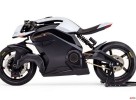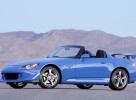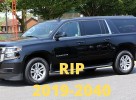"It's basically nothing more than a physics experiment."
Rarely do you hear drag racing - a sport which involves massive power and mind-numbing speed, blistering blacktop and ear-splitting sounds - compared to a physics experiment.
But to Victor Cagnazzi, co-owner of Gray Motorsports in North Carolina, that's exactly what drag racing is - a physics experiment.
"It's the application of physics to accelerate the car that's really exciting. There's a tremendous amount of technology wrapped around the cars, a tremendous amount of data acquisition and a tremendous amount of data analysis just for six second runs because we're trying to improve something a thousandth of a second at a time."
Physics, the "study of matter and its motion through space and time," deals predominantly with both energy and force - two fundamental agencies Cagnazzi is all too familiar with.
For Cagnazzi, racing, the great physics experiment, is about harnessing that energy. It's about developing, producing and aiming that force - gargantuan, ground-shaking speed, the likes of which can't truly be appreciated in mere words.
But Cagnazzi does his best to explain, to help me understand, anyway.
"It's trying to accelerate something and, you're basically taking a car from a dead stop, it is standing still, and accelerating it to 200 miles an hour in six seconds. Now, most cars, when you hear people talk about zero to 60 times, a fast car might be 2.7 seconds. Our cars are going zero to 60 in about 8/10ths of a second.
"And going from zero to about 210 miles per hour in about six seconds."
For Cagnazzi, who founded Cagnazzi Racing in the early 2000's before merging, just prior to last season, with Gray Motorsports, his relationship with racing - and hot rods in particular - is a deep-seated love affair he can trace to the very roots of his childhood on Long Island.
"My uncle, my father's brother, always had an interest in cars and when I was young I would watch him work on the cars that he had - he had a little hankering for performance cars - and it kind of got my interest started when I was young. Probably 8 or 9 years old I really started to build little car models and kind of just anything cars I got very interested in and as I got a little bit older my dad took me to a bunch of races out on Long Island and by the time I was about 16 or 17 years old I was building my own cars."
An avid hobby turned quickly into a passion, nearly an obsession, and a part of him that he can never, would never, move away from - has in fact, spent his entire life, moving toward.
***
Like any young man discovering his life's passion, Cagnazzi, who grew up in Centerport, New York, jumped into the world of racing head-first, finding himself behind the wheel as a teenager, eager to leave his lasting mark on the world of performance automobiles.
"I drove myself - amateur I drove for about 15 or 18 years, tried professionally for two, found out that my aptitude was not so much in the driving," he admits with a wry laugh.
Undeterred, he forged a new path for himself - a path that never strayed from the sport he so dearly loves, but one that moved him out of the driver's seat and into the true heart, the real birthplace of racing - engineering.
"I stepped out of the driver's seat and kind of focused on really helping the performance and building the initiatives that helped us to be more competitive and actually ended up enjoying that more than driving."
In short, he became the man behind the mask, the wizard behind the curtain, the physicist building, tweaking, and testing that experiment in gut-wrenching, mind-blowing speed.
Cagnazzi had already found his passion - now he'd found his calling.
"I wasn't that good of a driver but I certainly was a good engineer and had the ability, with God's blessings, to wrap the right people into what we were doing."
Cagnazzi, always quick to make comments about the immense success his team has been able to find - from 2005 to 2010, Cagnazzi's team has won 67% of Pro Stock Drag races, including two Pro Stock series championships while setting a number of NHRA records - with a humble acknowledgement of the great fortune he's experienced in the world of racing, also knows that it's the resources, the technology, the people he surrounds himself with that have allowed him to build a championship-caliber race team.
"We've kind of applied our technology background of applying the best people and the best resources to a given goal and it changed the dynamic of that type of racing at the time and we've been very successful as a group."
When the conversation shifts to the nuts and bolts of the organization, to the actual development and implementation of a plan to build and sustain the entire operation behind a successful racing team, you can hear the change come over his voice; you can sense the excitement, the palpable joy Cagnazzi feels at this segment of creating and maintaining the business.
"You have to obviously start with designing a facility and building that, finding the location where you want and we picked the location where we thought we'd have the biggest benefit surrounding us."
The first step was a 2002 relocation from New York to Mooresville, North Carolina, smack-dab in the heart of NASCAR country, which, as Cagnazzi points out, is "circle-track racing," an entirely different animal than the NHRA Pro Stock drag-racing Cagnazzi and Gray Motorsports are known for.
But the surrounding infrastructure - an industrial park in Mooresville "might consist of 30 or 40 race teams" he says - afforded by the move, combined with the region's avid and almost obsessive fan base, was a boon to Cagnazzi in his plans to build a racing team, too beneficial to pass up.
Whether being closer to parts fabricators, fellow engineering facilities, or the proximity to businesses interested in climbing onboard the team as sponsors, the move to North Carolina was Cagnazzi's first major race-team-building initiative.
But, like any great executive, any great businessman, he knew from the beginning he'd only ever go as far as the people he surrounded himself with. He, even now, knows it's the human element that really drives - literally and figuratively - his success.
So, he searched for the best and brightest and made them an integral part of his operation.
For Cagnazzi, it was about "finding the proper talent to achieve the goals that we wanted to, knowing that we did have some engineering staff and some mechanical staff and some people that were good with their hands and fabricating things."
Now, more than a decade after assembling the initial team, Cagnazzi feels a renewed excitement at the recent joining of forces with Gray - building what the organization's website dubs a "Super-Team."
"Our merger with Gray put two great teams together with a tremendous support staff and infrastructure and some very talented people. When we look at the folks that we have in key roles, we won two championships but we have actually personnel within our organization that now are responsible for the last six."
The new Super-Team set up entails engine development for both the Pro Stock and Cagnazzi's COPO Camaro Stock programs at the Gray Motorsports facility in Denver, North Carolina and chassis development for both at Cagnazzi's facility in Mooresville.
It's a fully formed economic vision that includes both the race team and in-house engine crafting for circle-track racing, modifieds, late models, sprint cars, stock cars and hobby stocks for IMCA competition.
With drivers Shane and nephew Jonathan Gray and the recently added multi-class maven Dave Connolly behind the wheels of the team's Chevrolet Camaros and combined with Cagnazzi's engineering, experience and organization-building prowess, the three-car race squad has already managed to leave a significant mark on the NHRA Pro Stock world.
There have been stumbling blocks in this lifelong pursuit of Cagnazzi's, of course. Starting a business, let alone a racing team, is an oftentimes perilous endeavor fraught with a myriad of pratfalls and difficult decisions.
For Cagnazzi, as for many U.S. businesses, the recession of the late 2000's meant that advertising revenue was difficult to come by. He watched as many of his racing brethren fell by the wayside, bankrupted by a down-economy and left wanting by surrounding businesses struggling mightily in their own right just to keep the doors open, stretched too thin to spend the money to have their name plastered on the side of a race car.
Still, he, and the team, persevered and, in time, again flourished.
"We were extremely fortunate that because of our track record the sponsors that were still interested in investing in the sport came to us, but for a lot of teams it was a difficult time to sell advertising space on race cars when there were so many other things that companies were focused on."
Now, boasting an even stronger team around him, buoyed by a track record of Pro Stock success and looking to build on last season's momentum, Cagnazzi sees a bright future for Gray Motorsports.
"I see a tremendous opportunity for us to grow. So as we look at 2015 and beyond, we are pretty excited about what our prospects are to continue to win races and win championships."
The physics of it all, the great experiment, continues for Cagnazzi, a lifetime's worth of lessons learned and challenges overcome now his greatest asset as he and the entire Gray Motorsports team forge ahead as the present and, hopefully, the future, of NHRA Pro Stock racing.
See Now: OnePlus 6: How Different Will It Be From OnePlus 5?






















